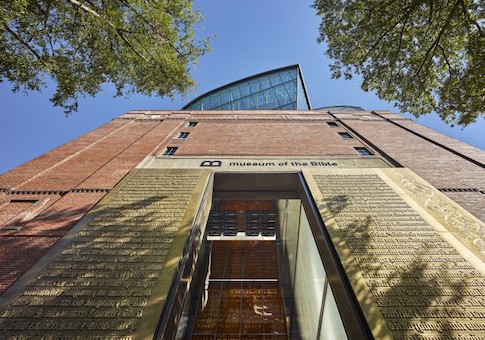Of the Bible's significance, nothing can be added to two sentences at the heart of Deuteronomy's Shema. "And these words which I command you today shall be in your heart. You shall teach them diligently to your children, and shall talk of them when you sit in your house, when you walk by the way, when you lie down, and when you rise up."
Whether you believe this command is of God or not, and increasingly Americans do not, you cannot claim it has gone disobeyed. The Museum of the Bible, dedicated and opened Friday, is an ambitious attempt to set forth the most famous book in history's place in society's story. It succeeds. And, in the margins and between the lines, it sets forth our place in the Bible's story.
Whatever canon is ascribed to, the Bible tells a story of sanctifying time through sanctifying space. From the covenant with Abraham that his descendants would be in the Land a nation among the nations, to the annunciation of her son to Mary in the village of Nazareth, the grand narratives of the Bible are played out in the dust and seas, the milk and honey, of a little patch of earth on the edges of empires. And the book's cosmic story of creator and creature and divine redemption plot, its vision of time in light of eternity, was in turn remade into a particular something in space: a scroll, a manuscript, a book.
In his short novel Helena, Evelyn Waugh recounts the mother of Constantine's decision to become the patroness of Jerusalem's pilgrim sites. Helena concluded, quite logically, that if Christianity makes historical claims there should be historical evidence, and with it, objects and associated locations convenient for and demanding the building of churches. And if she has the money to pay for building them then they ought be built. Though aiming to be nonsectarian (BCE and CE, not BC and anno Domini), the Museum of the Bible is an endeavor in a similar vein by Hobby Lobby president and museum chairman Steve Green and friends. The Bible is the most important—the banal might say best-selling—book of all time; there is evidence and detritus of how it came to be and where it has been, of what it has done and where it is going; there is money, clearly Solomonic amounts of money, to be spent. Spend it they have, to the tune of more than $500 million, and built it, and it is extraordinary.
The museum has eight floors for a total of 430,000 square feet—I leave to you the calculation of cubits. One floor alone apparently (and it is visually apparent) has more than 600 artifacts. At a press preview, Cary Summers, the museum's president, said it would take 72 hours to read every placard, watch every video, and participate in every experience it offers. I believe him. But I cannot afford to give it nine full days of work, so I look forward to slowly excavating its exhibits with the luxury of living here in the capital. Tourists who have not made that expensive and overrated lifestyle choice, never fear, you'll only need a few hours to see the core of the museum at a reasonable pace. The second through fourth floors contain the Museum of the Bible's heart: the History, Stories, and Impact of the Bible in descending order.
That's the story we are here for, well organized and clear. Where did this book on my nightstand come from? How did fragments of ancient near-east writings become compiled and stitched into the Tanakh? Who are all these translators producing the Septuagint? Seventy, really? Add on the Christian gospels and epistles in Aramaic and Greek. Translate it all into Latin. Do more translating. German? Now it's in English. King James is Authorizing things. More translating. Wow, I can hear it in so many languages (I literally can; the museum features audio of readings in original and translated languages throughout). Now everyone seems to have read it. It's popping up in art and science and literature, architecture and—is that clothing?
No one goes to the trouble of building this magnificent museum without loving its subject. It is by people who love the Bible, for people who love, like, or are merely interested in the Bible. Its purpose is "to invite all people to engage with the Bible," said Steve Bickley, a museum spokesman. The museum has its admitted and expected moments of theme-park gimmick, such as the Washington Revelations flyboard experience, extensive video elements, and a cafe called "Manna." But those elements work, are not cheap, and showcase the museum's concern for all ages and academic interests. Of course, if you are committed to finding things to gnash teeth over you'll find them. Impact of the Bible, with its celebratory sections on the Bible in American history and the development of modern culture, will make dogmatic secularists sigh very loudly while the people around them enjoy the displays. Why such bores would bother going is beyond me, though.
The Bible makes graspable a cosmic narrative. The Museum of the Bible sets out to do much the same for that book, ordering time and space for our access and understanding as they relate to this most universal of relics. All museums set out to make abstractions navigable and to bring near to us material that was far away. But at the Museum of the Bible we see this task compounded on itself, as the history of the object is presented along with the object's shaping of history. The museum's testament to the way "these words which I command you" have truly been in human hearts, and to the diligence with which the Bible has been taught and spoken of, is itself obedience to the command of the Shema.
